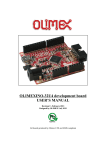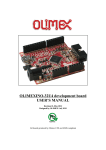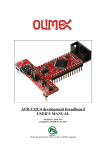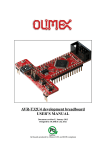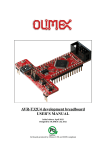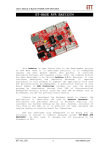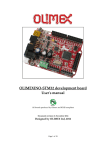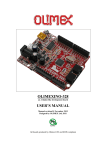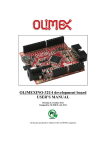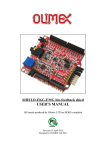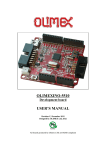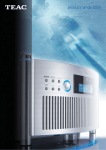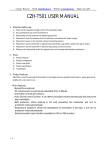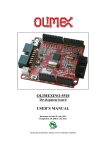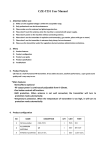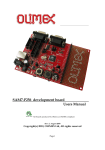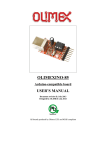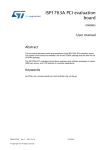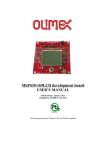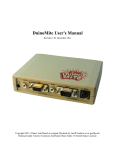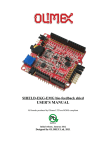Download OLIMEXINO-32U4 development board USER`S MANUAL
Transcript
OLIMEXINO-32U4 development board USER’S MANUAL Revision G, January 2015 Designed by OLIMEX Ltd, 2013 All boards produced by Olimex LTD are ROHS compliant OLIMEX© 2015 OLIMEXINO-32U4 user's manual © 2015 Olimex Ltd. Olimex®, logo and combinations thereof, are registered trademarks of Olimex Ltd. Other product names may be trademarks of others and the rights belong to their respective owners. The information in this document is provided in connection with Olimex products. No license, express or implied or otherwise, to any intellectual property right is granted by this document or in connection with the sale of Olimex products. This work is licensed under the Creative Commons Attribution-ShareAlike 3.0 Unported License. To view a copy of this license, visit http://www.creativecommons.org/licenses/by-sa/3.0/. This hardware design by Olimex LTD is licensed under a Creative Commons Attribution-ShareAlike 3.0 Unported License. The software is released under GPL. It is possible that the pictures in this manual differ from the latest revision of the board. The product described in this document is subject to continuous development and improvements. All particulars of the product and its use contained in this document are given by OLIMEX in good faith. However all warranties implied or expressed including but not limited to implied warranties of merchantability or fitness for purpose are excluded. This document is intended only to assist the reader in the use of the product. OLIMEX Ltd. shall not be liable for any loss or damage arising from the use of any information in this document or any error or omission in such information or any incorrect use of the product. This evaluation board/kit is intended for use for engineering development, demonstration, or evaluation purposes only and is not considered by OLIMEX to be a finished end-product fit for general consumer use. Persons handling the product must have electronics training and observe good engineering practice standards. As such, the goods being provided are not intended to be complete in terms of required design-, marketing-, and/or manufacturing-related protective considerations, including product safety and environmental measures typically found in end products that incorporate such semiconductor components or circuit boards. Olimex currently deals with a variety of customers for products, and therefore our arrangement with the user is not exclusive. Olimex assumes no liability for applications assistance, customer product design, software performance, or infringement of patents or services described herein. THERE IS NO WARRANTY FOR THE DESIGN MATERIALS AND THE COMPONENTS USED TO CREATE OLIMEXINO-32U4. THEY ARE CONSIDERED SUITABLE ONLY FOR OLIMEXINO-32U4. Page 2 of 28 OLIMEX© 2015 OLIMEXINO-32U4 user's manual Table of Contents CHAPTER 1 OVERVIEW......................................................................................... 5 1. Introduction to the chapter.......................................................................................................5 1.1 Features.....................................................................................................................................5 1.2 Similar boards..........................................................................................................................6 1.3 Organization.............................................................................................................................6 CHAPTER 2 INTRODUCTION TO ARDUINO..................................................... 7 2. What is Arduino?.......................................................................................................................7 2.1 First steps with Arduino IDE..................................................................................................8 CHAPTER 3 SETTING UP THE OLIMEXINO-32U4 BOARD.........................10 3. Introduction to the chapter.....................................................................................................10 3.1 Electrostatic warning.............................................................................................................10 3.2 Requirements......................................................................................................................... 10 3.3 Powering the board................................................................................................................10 3.4 Prebuilt software....................................................................................................................10 CHAPTER 4 OLIMEXINO-32U4 BOARD DESCRIPTION............................... 11 4. Introduction to the chapter..................................................................................................... 11 4.1 Layout (top view)................................................................................................................... 11 CHAPTER 5 THE ATMEGA32U4 MICROCONTROLLER..............................12 5. Introduction to the chapter.....................................................................................................12 5.1 The microcontroller's features..............................................................................................12 CHAPTER 6 CONTROL CIRCUITY.................................................................... 14 6. Introduction to the chapter.....................................................................................................14 6.1 Reset........................................................................................................................................14 6.2 Clock....................................................................................................................................... 14 CHAPTER 7 HARDWARE......................................................................................15 7. Introduction to the chapter.....................................................................................................15 7.1 Battery connector...................................................................................................................15 7.2 ICSP pin holes........................................................................................................................ 15 7.3 UEXT...................................................................................................................................... 16 7.4 Arduino shield pin holes........................................................................................................17 7.5 USB mini connector...............................................................................................................18 7.6 Jumper description................................................................................................................18 7.7 Additional hardware components........................................................................................ 19 CHAPTER 8 MEMORY AND BLOCK DIAGRAM.............................................20 8. Introduction to the chapter.....................................................................................................20 8.1 Memory organization............................................................................................................ 21 CHAPTER 9 SCHEMATICS...................................................................................22 Page 3 of 28 OLIMEX© 2015 OLIMEXINO-32U4 user's manual 9. Introduction to the chapter.....................................................................................................22 9.1 Eagle schematic......................................................................................................................22 9.2 Physical dimensions...............................................................................................................24 CHAPTER 10 REVISION HISTORY.....................................................................25 10. Introduction to the chapter...................................................................................................25 10.1 Document revision............................................................................................................... 25 10.2 Board revision...................................................................................................................... 26 10.3 Web page of your device......................................................................................................27 10.4 Warranty and returns..........................................................................................................28 Page 4 of 28 OLIMEX© 2015 OLIMEXINO-32U4 user's manual CHAPTER 1 OVERVIEW 1. Introduction to the chapter Thank you for choosing the OLIMEXINO-32U4 development board from Olimex! This document provides a User’s Guide for the Olimex OLIMEXINO-32U4 development board. As an overview, this chapter gives the scope of this document and lists the board’s features. The document’s organization is then detailed. The OLIMEXINO-32U4 development board enables code development of applications running on the ATmega32U4 microcontroller, manufactured by Atmel Corporation. 1.1 Features • • • • • • • • • • • • • • • Leonardo design – no FTDI chip, the MCU directly handles the virtual COM ATMEGA32U4 microcontroller, all in one USB communication no need for external FTDI chip. Input power supply 7-12VDC ULTRA LOW POWER voltage regulators and the consumption is only few microamps, which enables hand-held and battery powered applications. Li-Ion rechargeable battery power supply option with BUILD-IN on board charger, so when you attach battery it is automatically charged and kept in this state until the other power source (USB or external adapter) is removed and it AUTOMATICALLY will power the board – no jumpers, no switches! Works both on 3.3V and on 5V which is selectable with jumper, so 3.3V and 5V shields can be used UEXT connector which allow many existing modules like RF, ZIGBEE, GSM, GPS to be connected Allows RTC – Real Time Clock (Q1 can be replaced by RTC). NOISE IMMUNE design the LEDs and the button BUT are on the edge of the board so there is easy access even if the boards have shields on them all components are LOWER than the connectors, so the shields do not interference with them mini USB connector is used -it is common and used in most cell phones, so you don't have to buy other cables Original design had a flaw – the connectors were not spaced at 0.1" which made bread board use impossible, to keep the compatibility we have the original spacing but we also added a 0.1'' connector which customer can use with bread boards (and jumper wires) saving the hustle of soldering All signals on the connectors are printed on top of the board, so when you check with probe you know exactly which port you are measuring 4 mount holes make board attachment easier Page 5 of 28 OLIMEX© 2015 OLIMEXINO-32U4 user's manual 1.2 Similar boards OLIMEXINO-32U4 is an ARDUINO-LEONARDO-like board with ATmega32U4. It is a powerful board considering its low price but yet a starter board for the Arduino family. The more powerful Arduino board we have in the range is OLIMEXINO-328 – based on Arduino Duemilanove. It has a more sophisticated supply circuit, USB OTG connector and there are more Arduino projects available. 1.3 Organization Each section in this document covers a separate topic, organized as follow: – Chapter 1 is an overview of the board usage and features – Chapter 2 has a short introduction to Arduino platform and its derivatives Pinguino and Maple – Chapter 3 provides a guide for quickly setting up the board – Chapter 4 contains the general board diagram and layout – Chapter 5 describes the component that is the heart of the board: the ATmega32U4 microcontroller – Chapter 6 is an explanation of the control circuitry associated with the microcontroller to reset. Also shows the clocks on the board – Chapter 7 covers the connector pinout, peripherals and jumper description – Chapter 8 shows the processor diagram and memory map – Chapter 9 provides the schematics – Chapter 10 contains the revision history Page 6 of 28 OLIMEX© 2015 OLIMEXINO-32U4 user's manual CHAPTER 2 INTRODUCTION TO ARDUINO 2. What is Arduino? Arduino is an open-source electronics prototyping platform, designed to make the process of using electronics in multidisciplinary projects easily accessible. The hardware consists of a simple open hardware design for the Arduino board with an Atmel AVR processor and on-board I/O support. The software consists of a standard programming language and the boot loader that runs on the board. Arduino hardware is programmed using a Wiring-based language (syntax + libraries), similar to C+ + with some simplifications and modifications, and a Processing-based Integrated Development Environment (IDE). The project began in Ivrea, Italy in 2005 aiming to make a device for controlling student-built interaction design projects less expensively than other prototyping systems available at the time. As of February 2010 more than 120,000 Arduino boards had been shipped. Founders Massimo Banzi and David Cuartielles named the project after a local bar named Arduino. The name is an Italian masculine first name, meaning "strong friend". The English pronunciation is "Hardwin", a namesake of Arduino of Ivrea. More information could be found at the creators web page http://arduino.cc/ and in the Arduino Wiki http://en.wikipedia.org/wiki/Arduino To make the story short – Arduino is easy for beginners who lack Electronics knowledge, but also does not restrict professionals as they can program it in C++ or mix of Arduino/C++ language. There are thousands of projects which makes it easy to startup as there is barely no field where Arduino enthusiasts to have not been already. Arduino has inspired two other major derivatives – MAPLE and PINGUINO. Based on 8-bit AVR technology the computational power of Arduino boards is modest, this is why a team from MIT developed the MAPLE project which is based on ARM7 STM32F103RBT6 microcontroller. The board has same friendly IDE as Arduino and offers the same capabilities as hardware and software but runs the Arduino code much faster. The Maple project can be found at http://leaflabs.com In parallel with Arduino another project was started called PINGUINO. This project chose its first implementation to be with PIC microcontrollers, as AVRs were hard to find in some parts of the world like South America so it is likely to see lot of PINGUINO developers are from that part of the world. PINGUINO project founders decided to go with Python instead Java for processing language. For the moment PINGUINO is much more flexible than Arduino as it is not limited to 8bit microcontrollers. Currently the IDE, which has GCC in background, can support 8-bit PIC microcontrollers, 32bit PIC32 (MIPS) microcontrollers and ARM7/CORTEXM3 microcontrollers which makes PINGUINO very flexible because once you make your project you can migrate easily through different hardware platforms and not being bound to a single microcontroller manufacturer. The PINGUINO project can be found at: http://www.pinguino.cc. Page 7 of 28 OLIMEX© 2015 OLIMEXINO-32U4 user's manual 2.1 First steps with Arduino IDE Depending when you purchased the board there are two scenarios since the PID (product ID) which is stored in the firmware and expected by the IDE is different between versions 1.0.0 and 1.0.1 (1.0.1 is the first release of the Arduino IDE with official support for Leonardo). 2.1.1 For purchases after the official release of Leonardo Boards produced after the official release of Arduino Leonardo have the latest bootloader available with the adjusted bootloader PID. Download the latest Arduino IDE and extract the package. You can find the needed driver for the bootloader located in folder /drivers. You click update on the device in device manager and point the installer to the /drivers folder. Then launch Arduino IDE and set the correct board and COM port in TOOLS menu. From File->Open navigate to the examples folder which is found in the Arduino IDE installation folder. Choose a simple example to begin with like BlinkWithoutDelay.ino and open it. Click verify and after it compiles click “Upload”. Voila, you have uploaded code to your Arduino device. Now start exploring the world of Arduino! More info and help on the software can be found and the official Arduino web site: http://www.arduino.cc/. 2.1.2 For purchases before the official release of Leonardo If you have purchased the OLIMEXINO-32U4 before the official release of the Arduino Leonardo board there are two scenarios for using Arduino IDE: 1) Download Arduino IDE 1.0 RC2 or Arduino IDE 1.0.0. When you extract the package check if the Arduino Leonardo section is the \hardware\arduino\boards is uncommented. If the section has number signs (#) infront remove the number signs (#). 2) If you want to use the latest version (which by the time of writing is 1.0.1) you would need to change to bootloader firmware. This will require an AVR programmer tool. You can get the bootloader in .elf format from our web site. You can also use the original bootloader hex if you set the fuses and lock bits for the processor as follows: low_fuses=0xff high_fuses=0xd8 extended_fuses=0xcb lock_bits (choose “SPM Prohibited in Boot Section”) from the drop down menu which will set the bits either to EF or 2F) After you have downloaded and extracted the desired IDE you need to install the driver for your operating system. You can find the needed driver for the bootloader located in folder /drivers. You click update on the device in device manager and point the installer to the /drivers folder. Then launch Arduino IDE and set the correct board and COM port in TOOLS menu. Page 8 of 28 OLIMEX© 2015 OLIMEXINO-32U4 user's manual From File->Open navigate to the examples folder which is found in the Arduino IDE installation folder. Choose a simple example to begin with like BlinkWithoutDelay.ino and open it. Click verify and after it compiles click “Upload”. Voila, you have uploaded code to your Arduino device. Now start exploring the world of Arduino! More info and help on the software can be found and the official Arduino web site: http://www.arduino.cc/. Page 9 of 28 OLIMEX© 2015 OLIMEXINO-32U4 user's manual CHAPTER 3 SETTING UP THE OLIMEXINO-32U4 BOARD 3. Introduction to the chapter This section helps you set up the OLIMEXINO-32U4 development board for the first time. Please consider first the electrostatic warning to avoid damaging the board, then discover the hardware and software required to operate the board. The procedure to power up the board is given, and a description of the default board behavior is detailed. 3.1 Electrostatic warning OLIMEXINO-32U4 is shipped in a protective anti-static package. The board must not be exposed to high electrostatic potentials. A grounding strap or similar protective device should be worn when handling the board. Avoid touching the component pins or any other metallic element. 3.2 Requirements In order to set up the OLIMEXINO-32U4, the following items are required: If using the free ARDUINO IDE the ONLY requirement is a miniUSB to USB-A cable to connect to a computer. If you want to upgrade the bootloader, or program the board without the ARDUINO-IDE there are pinouts for ICSP programmer (note that there isn't a connector mounted). You can use our AVRISP-MK2, or AVR-ISP500 programmer for custom programming without ARDUINO IDE. Having an AVR programmer is highly advisable since the bootloader software is still not perfect and it is possible to destroy it only by software means (remap pins used for programming) which would require reinstalling the bootloader. 3.3 Powering the board The OLIMEXINO-32U4 board is self-powered by the miniUSB if it is connected to a USB hub of a computer. Alternatively, it can be powered via the POWER JACK by 7Vdc to 12Vdc or via the 3.7V-LI_BAT connector by 3.7V battery. The bootloader starts automatically. On powering the board PWR_LED should turn on. RXLED and TXLED should turn on and monitor the send receive on the virtual COM port. LED1 and LED2 should start blinking. 3.4 Prebuilt software The board comes with prebuilt ARDUINO bootloader. The different part between the other Arduinos and Leonardo is that Leonardo doesn't use FTDI chip nor external chip for the virtual COM port but it is handled by the ATmega32U4. Page 10 of 28 OLIMEX© 2015 OLIMEXINO-32U4 user's manual CHAPTER 4 OLIMEXINO-32U4 BOARD DESCRIPTION 4. Introduction to the chapter Here you get acquainted with the main parts of the board. Note the names used on the board differ from the names used to describe them. For the actual names check the OLIMEXINO-32U4 board itself. 4.1 Layout (top view) Page 11 of 28 OLIMEX© 2015 OLIMEXINO-32U4 user's manual CHAPTER 5 THE ATMEGA32U4 MICROCONTROLLER 5. Introduction to the chapter In this chapter is located the information about the heart of OLIMEXINO-32U4 – its microcontroller. The information is a modified version of the datasheet provided by its manufacturers. 5.1 The microcontroller's features • High Performance, Low Power AVR® 8-Bit Microcontroller • Advanced RISC Architecture – 135 Powerful Instructions – Most Single Clock Cycle Execution – 32×8 General Purpose Working Registers – Fully Static Operation – Up to 16 MIPS Throughput at 16 MHz – On-Chip 2-cycle Multiplier • Non-volatile Program and Data Memories – 32K Bytes of In-System Self-Programmable Flash – 2.5K Bytes Internal SRAM – 1K Bytes Internal EEPROM – Write/Erase Cycles: 10,000 Flash/100,000 EEPROM – Data retention: 20 years at 85°C/ 100 years at 25°C(1) – Optional Boot Code Section with Independent Lock Bits In-System Programming by On-chip Boot Program True Read-While-Write Operation All supplied parts are preprogramed with a default USB bootloader – Programming Lock for Software Security • JTAG (IEEE std. 1149.1 compliant) Interface – Boundary-scan Capabilities According to the JTAG Standard – Extensive On-chip Debug Support – Programming of Flash, EEPROM, Fuses, and Lock Bits through the JTAG Interface • USB 2.0 Full-speed/Low Speed Device Module with Interrupt on Transfer Completion – Complies fully with Universal Serial Bus Specification Rev 2.0 – Supports data transfer rates up to 12 Mbit/s and 1.5 Mbit/s – Endpoint 0 for Control Transfers: up to 64-bytes – 6 Programmable Endpoints with IN or Out Directions and with Bulk, Interrupt or Isochronous Transfers – Configurable Endpoints size up to 256 bytes in double bank mode – Fully independent 832 bytes USB DPRAM for endpoint memory allocation – Suspend/Resume Interrupts – CPU Reset possible on USB Bus Reset detection – 48 MHz from PLL for Full-speed Bus Operation – USB Bus Connection/Disconnection on Microcontroller Request – Crystal-less operation for Low Speed mode • Peripheral Features Page 12 of 28 OLIMEX© 2015 OLIMEXINO-32U4 user's manual – On-chip PLL for USB and High Speed Timer: 32 up to 96 MHz operation – One 8-bit Timer/Counter with Separate Prescaler and Compare Mode – Two 16-bit Timer/Counter with Separate Prescaler, Compare- and Capture Mode – One 10-bit High-Speed Timer/Counter with PLL (64 MHz) and Compare Mode – Four 8-bit PWM Channels – Four PWM Channels with Programmable Resolution from 2 to 16 Bits – Six PWM Channels for High Speed Operation, with Programmable Resolution from 2 to 11 Bits – Output Compare Modulator – 12-channels, 10-bit ADC (features Differential Channels with Programmable Gain) – Programmable Serial USART with Hardware Flow Control – Master/Slave SPI Serial Interface – Byte Oriented 2-wire Serial Interface – Programmable Watchdog Timer with Separate On-chip Oscillator – On-chip Analog Comparator – Interrupt and Wake-up on Pin Change – On-chip Temperature Sensor • Special Microcontroller Features – Power-on Reset and Programmable Brown-out Detection – Internal 8 MHz Calibrated Oscillator – Internal clock prescaler & On-the-fly Clock Switching (Int RC / Ext Osc) – External and Internal Interrupt Sources – Six Sleep Modes: Idle, ADC Noise Reduction, Power-save, Power-down, Standby, and Extended Standby • I/O and Package – All I/O combine CMOS outputs and LVTTL inputs – 26 Programmable I/O Lines – 44-lead QFN Package, 7×7mm • Operating Voltages – 2.7 – 5.5V • Operating temperature – Industrial (-40°C to +85°C) • Maximum Frequency – 8 MHz at 2.7V – Industrial range – 16 MHz at 4.5V – Industrial range For comprehensive information on the microcontroller visit the Atmel web page for a datasheet. At the moment of writing the microcontroller datasheet can be found at the following link: http://www.atmel.com/Images/doc7766.pdf Page 13 of 28 OLIMEX© 2015 OLIMEXINO-32U4 user's manual CHAPTER 6 CONTROL CIRCUITY 6. Introduction to the chapter Here you can find information about reset circuit, power circuit and quartz crystal locations. 6.1 Reset OLIMEXINO-32U4 reset circuit includes R7 (4.7kΩ), R8 (330Ω), D1 (Shottky diode), ATmega32U4 pin 13 (#RESET) and a RESET button. Note that it also can be found at the ICSP header pin 5 and power connector pin 1. 6.2 Clock 16MHz quartz crystal Q1 is found at pins 16 and 17 of the processor. By default OLIMEXINO-32U4 operates at 5V, which allows the main microcontroller (ATmega32u4) to operate properly at the maximum clock speed (16 MHz). The ATmega32u4 would work properly at 16MHz only if powered by at least 4.5V. If you decide to change the position of the jumper 3.3V/5V jumper to 3.3V position, please note that, at 3.3V, the maximum frequency that can be achieved with ATmega32u4 is around 10MHz, thus the 16MHz operation is a significant overclock. Yet, our tests proved that the board works reliably with a 16MHz qaurtz even at 3.3V. IMPORTANT: If the board has a quartz crystal rotated at 45 degrees relative to the pads provided do not panic. This is normal. We have two types of such crystals – one of them requires 4 pads, the other only 2 pads. That is why we have provided 4 pads to be able to fit both crystals. All boards Olimex manufactures pass automatized optical inspection after assembly and obvious misplacement like this is impossible to occur. Page 14 of 28 OLIMEX© 2015 OLIMEXINO-32U4 user's manual CHAPTER 7 HARDWARE 7. Introduction to the chapter In this chapter are presented the connectors that can be found on the board all together with their pinout. Jumpers functions are described. Notes and info on specific peripherals are presented. Notes regarding the interfaces are given. 7.1 Battery connector The battery connector is suitable for 3.7V LiPo batteries. The board has a built-in charger circuit, so when the main power supply is restored the battery would get recharged automatically. Pin # Signal Name 1 VBAT 2 GND 7.2 ICSP pin holes The 6 pin ICSP header provides interface for custom programming/debugging outside of the Arduino IDE. Note the pin holes doesn't have a connector mounted over – you have to mount it/solder it yourself. The pinout can be found in the table below. It is important to check the jumper configuration for proper use of the ICSP pin hole. ICSP pin holes Pin # Signal name Pin # Signal name 1 D14(MISO) 4 D16(MOSI) 2 Vcc 5 RESET 3 D15(SCK) 6 GND Page 15 of 28 OLIMEX© 2015 OLIMEXINO-32U4 user's manual 7.3 UEXT OLIMEXINO-32U4 board has UEXT connector and can interface Olimex's UEXT modules. For more information on our UEXT modules please visit: https://www.olimex.com/Products/Modules/UEXT/ Pin # Signal name 1 +3.3V 2 GND 3 D1(TXD) 4 D0(RXD) 5 D3(SCL) 6 D2(SDA) 7 D14(MISO) 8 D16(MOSI) 9 D15(SCK) 10 D13(UEXT_#CS) It is important to note that there are 4.7k pull-up resistors on the I2C lines – SCL/SDA (D3 and D2 respectively). You can disconnect/disable the resistors by cutting between the pads of the small SMT jumpers R11_E and R12_E. The chip select pin – CS (D13) also has a 4.7k pull-up resistor which might be disabled by cutting R13_E. Page 16 of 28 OLIMEX© 2015 OLIMEXINO-32U4 user's manual 7.4 Arduino shield pin holes For your convenience the pads are named individually near each of them. Please take extra care about the numbering but consider that there might be offset. Pad Name Signal Pad Name POWER CON1 Signal DIGITAL CON2 RST RESET A0 PF7/ADC7/TDI 3V3 +3.3 V A1 PF6/ADC6/TDO 5V +5 V A2 PF5/ADC5/TMS GND GROUND A3 PF4/ADC4/TCK GND GROUND A4 PF1/ADC1 VIN V in A5 PF0/ADC0 DIGITAL CON3 DIGITAL CON4 D0(RXD) PD2/RXD1/INT2 D8(UEXT_PWR_E) D1(TXD) PD3/TXD1/INT3 D9(LED2) D2(SDA) PD1/SDA/INT1 D10 PB6/PCINT6/OC1B/OC4B/ADC 13 D3(SCL) PD0/OC0B/SCL/ INT0 D11 PB7/PCINT7/OC0A/OC1C/ #RTS D4 PD4/ICP1/ADC8 D12 PD6/T1/#OC4D/ADC9 D5 PC6/OC3A/ #OC4A D13(UEXT_#CS) PC7/ICP3/CLK0/OC4A D6 PD7/T0/OC4D/A DC10 GND GND D7(LED1) INT6/AIN0/PE6 AREF AREF SDA D2(SDA) SCL D3(SCL) Page 17 of 28 RB4/PCINT4/ADC11 PB5/PCIN5/OC1A/#OC4B/ ADC12 OLIMEX© 2015 OLIMEXINO-32U4 user's manual 7.5 USB mini connector Note that the USB is configured only as device. Pin # Signal Name 1 +5V 2 D- 3 D+ 4 Not connected 5 GND 7.6 Jumper description 3.3V/5V This jumper controls whether the board is powered by 3.3Vdc source or 5Vdc. Default position is 2-3 – 5Vdc. AGND_E When closed enables analog GND. SMD jumper. Default state is closed. FET3_E When closed connects D8 from Arduino shield connector to FET3 so you can control the power on the UEXT by software means. When open D8 becomes GPIO. This is a SMD type of jumper. Default state is closed. Page 18 of 28 OLIMEX© 2015 OLIMEXINO-32U4 user's manual LED1_E When closed enables LED1. SMD jumper. Default state is closed. LED2_E When closed enables LED2. SMD jumper. Default state is closed. RXLED_E When closed enables RXLED. SMD jumper. Default state is closed. TXLED_E When closed enables TXLED. SMD jumper. Default state is closed. R11_E, R12_E, R13_E When these jumpers are closed they enable 4.7k Ohm pull-up resistors on each of the I2C lines (R11_E is responsible for the resistor of SCL line, R12_E – for the SDA line, R13_E – for the UEXT_CS). SMD jumpers. Default state for all three is closed. 7.7 Additional hardware components The components below are mounted on the OLIMEXINO-32U4 board but are not discussed above. They are listed here for completeness: General-purpose button 2 general purpose LEDs 2 LEDs showing virtual port activity Note that connectors on the CON1, CON2, CON3, CON4 are soldered/mounted. Page 19 of 28 OLIMEX© 2015 OLIMEXINO-32U4 user's manual CHAPTER 8 MEMORY AND BLOCK DIAGRAM 8. Introduction to the chapter Below is located the block diagram of the processor and on the next page you can find a memory map for this family of processors. It is strongly recommended to refer to the original datasheet released by Atmel for ones of higher quality. Page 20 of 28 OLIMEX© 2015 OLIMEXINO-32U4 user's manual 8.1 Memory organization Page 21 of 28 OLIMEX© 2015 OLIMEXINO-32U4 user's manual CHAPTER 9 SCHEMATICS 9. Introduction to the chapter In this chapter are located the schematics describing logically and physically OLIMEXINO-32U4. 9.1 Eagle schematic OLIMEXINO-32U4 schematic is visible for reference here. You should zoom the pdf for a better view and also string search is available. You can also find a stand-alone pdf on the web page for OLIMEXINO-32U4 at our site: https://www.olimex.com/Products/Duino/AVR/OLIMEXINO32U4/. They are located in HARDWARE section. This work is licensed under the Creative Commons Attribution-ShareAlike 3.0 Unported License. To view a copy of this license, visit http://creativecommons.org/licenses/by-sa/3.0/. The EAGLE schematic is situated below for quicker reference. Page 22 of 28 OLIMEX© 2015 OLIMEXINO-32U4 user's manual OLIMEXINO-32U4 Rev.A3 Designed by: OLIMEX LTD, BULGARIA Web-address: https://www.OLIMEX.com DVCC AVCC RESET 13 #RESET AVCC AVCC 14 VCC 34 C3 UVCC 6 C4 VBUS 5 USB FB/600 OHM/1206(321611C-601) VBUS R1 R2 DD+ GND C9 20pF ID Q1 16 GND 16.000MHz/SMD5x3.2/12pF USB-MINI C610nF 18 D12 D6 26 C10 100nF A0 A1 A2 A3 A4 A5 1 A4 6 A5 1 D0 2 D1 3 D2 4 D3 5 D4 6 D5 7 D6 8 D7 D8(UEXT_PWR_E) D9(LED2) D10 D11 D12 D13(UEXT_#CS) D17(RXLED) D15(SCK) PD5/XCK1/CTS PB6/PCINT6/OC1B/OC4B/ADC13 D10 30 PB7/PCINT7/OC0A/OC1C/#RTS D11 12 PD6/T1/#OC4D/ADC9 PD7/T0/OC4D/ADC10 1 D8 2 D9 3 D10 4 D11 5 D12 6 D13 7 AREF D2(SDA) D3(SCL) GND 8 AREF 9 SDA 10 SCL NA This hardware design by Olimex LTD is licensed under a Creative Commons Attribution-ShareAlike 3.0 Unported License. STAT LEDS D7(LED1) R9 D1 NA[1N5819(S4SOD-123)] D9(LED2) TXLED ICSP D17(RXLED) D14(MISO) D15(SCK) RESET 4.7k LED1_E Close #HWB RESET LED2_E Close RXLED_E Close R17 2k C15 NA R10 330R DVCC ICSP 1 2 3 4 5 6 D16(MOSI) NA(HR2x3) BUT RST R8 330R A3 5 DVCC 4.7k A2 4 1xPN1x10+1xPN1x8+2xPN1x6 DVCC R7 A1 3 ATMEGA32U4-AU BUTTONS A0 2 D0(RXD) D1(TXD) D2(SDA) D3(SCL) D4 D5 D6 D7(LED1) PB4/PCINT4/ADC11 D8(UEXT_PWR_E) 28 PB5/PCINT5/OC1A/#OC4B/ADC12 29 D9(LED2) PD4/ICP1/ADC8 27 VIN CON2 PB2/PDI/PCINT2/MOSI D16(MOSI) 10 PB3/PDO/PCINT3/MISO 11 D14(MISO) PD3/TXD1/INT3 22 GND NA D7(LED1) #HWB PB0/SS/PCINT0 8 PB1/PCINT1/SCLK 9 PD2/RXD1/INT2 25 GND 6 CON4 PD1/SDA/INT1 21 5V 5 NA PD0/OC0B/SCL/INT0 20 3V3 3 XTAL1 19 RST 2 XTAL2 17 D3(SCL) D2(SDA) D0(RXD) D1(TXD) D4 TXLED A5 A4 A3 A2 A1 A0 PLATFORM1 1 4 D+ GND 22R 22R NA D- 4 XTAL2 XTAL1 C8 20pF L1 GND 3 PF0/ADC0 41 PF1/ADC1 40 INT6/AIN0/PE6 1 PE2/#HWB 33 GND 23 5V_USB NA PC7/ICP3/CLK0/OC4A 32 D13(UEXT_#CS) PC6/OC3A/#OC4A 31 D5 GND 15 DD+ CON1 RESET +5V CON3 GND 43 DD+ R23 NA UGND 35 AREF PF6/ADC6/TDO 37 PF7/ADC7/TDI 36 UCAP 7 AREF 42 PF4/ADC4/TCK 39 PF5/ADC5/TMS 38 VCC 2 C2 R22 VIN 44 C5 1uF/10V DVCC 3.3V U1 5V_USB 24 C1 DVCC R16 2k R15 2k R14 2k C16 100nF LED1 LED0603/GREEN LED2 LED0603/YELLOW TXLED LED0603/GREEN RXLED LED0603/YELLOW 3.3V_E DVCC 3.3V_E UEXT R19 0R(Board_Mounted) 3.3V_E 3.3V_E 0R FET3 IRLML6402 R11_E Close VIN 5V_USB +5V 3.3V/5V HR1x3(3.3V:Open/5V:Close) CHG_D 1 2 open 7-12VDC PWR D2 1N5819(S4SOD-123) 1N5819(S4SOD-123) IN OUT ADJ/GND +5V YDJ-1136 R5 2k 4 C17 VDD BATTERY CHARGER R4 AVCC 1 2 VSS L2 22uH/10%/5mA GND R21 10k 2 4.7k VBAT 3 VBAT R6 10k CE 1 PROG 5 1 C18 15k C22 10uF/6.3V 2 3.7V-LI_BAT DW02R - C20 100nF C21 10uF/6.3V AGND_E 1 2 CLOSE appr. 70 mA charge current This hardware design by Olimex LTD is licensed under a Creative Commons Attribution-ShareAlike 3.0 Unported License. Page 23 of 28 1 FET3_E D8(UEXT_PWR_E) Close UEXT 1 2 3 4 5 6 7 8 9 10 BH10R 330R/1% R18 C19 1uF/10V D1(TXD) D3(SCL) D14(MISO) D15(SCK) MCP73812T-420I/OT R3 100R/1% +5V R11 DVCC VIN VOUT 3 U2 5.375V +5V MCP1700T-3302E/MB 2 Battery Charger VR1(5.0V) AMS1117-ADJ 3.3V VR2(3.3V) D3 FET1 IRLML6402 R12_E Close R13_E Close R12 R13 4.7k 4.7k R20 100k POWER_SUPPLY +5V D0(RXD) D2(SDA) D16(MOSI) D13(UEXT_#CS) OLIMEX© 2015 OLIMEXINO-32U4 user's manual 9.2 Physical dimensions Note that all dimensions are in inches. Page 24 of 28 OLIMEX© 2015 OLIMEXINO-32U4 user's manual CHAPTER 10 REVISION HISTORY 10. Introduction to the chapter In this chapter you will find the current and the previous version of the document you are reading. Also the web-page for your device is listed. Be sure to check it after a purchase for the latest available updates and examples. 10.1 Document revision Revision Changes Modified Pages Initial Initial release All B C Manual adjusted for Arduino IDE version 1.0.1 Fixed links Adjusted formatting, fixed some mistakes, updated links 8, 9, 15 All Added info about the I2C Updated disclaimer and warranty pages D ICSP and UEXT connector changes due to new schematics 2, 15, 16, 17, 20, 22, 26, All Adjusted formatting, fixed some mistakes Fixed - “the LEDs and the BUTTONs are on the edge of the board so there is easy access even if the boards have shields on them” - not true for RST button E Fixed - “All signals on the connectors are printed on top and on bottom of the board, so when you check with probe you know exactly which port you are measuring” - not true with Olimexino-32u4 (only on component side) Fixed - “Proto area is shown.” - there is no proto are Fixed -”programming/debugging outside of the PINGUINO IDE” - should be ARDUINO IDE Fixed “Also note that the board comes with no Page 25 of 28 5, 14, 15, 17, 25 OLIMEX© 2015 OLIMEXINO-32U4 user's manual connectors soldered on the pin holes. Before being able to connect with a shield you have to solder connecters yourself.” - the shield connectors are already soldered Fixed the numbering of sub-chapters in chapter 7 Signal on D7 in the table is not BUT. Fixed title of “10.4 Web page of your device” to “10.4 Warranty and returns” F Added a note about rotated quartz crystal 14 G Added information about maximum frequency operation 14 Improved the board's schematic 22 10.2 Board revision Revision Changes A Initial release A2 Top and bottom print adjustments A3 Swapped D14 with D17 (this affects ICSP and UEXT connectors) in schematic names because they comply with the new Leonardo definitions and the SD card example works with these settings Page 26 of 28 OLIMEX© 2015 OLIMEXINO-32U4 user's manual 10.3 Web page of your device The web page you can visit for more info on your device is https://www.olimex.com/Products/Duino/AVR/OLIMEXINO-32U4/. There you can find more info and some examples. Web page of the original Arduino and Arduino software: http://arduino.cc/en/. ORDER CODES: OLIMEXINO-32U4 – completely assembled and tested USB-MINI-CABLE – USB mini to USB-A cable How to order? You can order directly from our web shop or by any of our distributors. Please check the list of distributors: https://www.olimex.com/Distributors/. Check our web site https://www.olimex.com/ for more info. Page 27 of 28 OLIMEX© 2015 OLIMEXINO-32U4 user's manual 10.4 Warranty and returns For product support, hardware information and error reports mail to: [email protected]. All document or hardware feedback is welcome. Note that we are primarily a hardware company and our software support is limited. Please consider reading the paragraph below about the warranty of Olimex products. All goods are checked before they are sent out. In the unlikely event that goods are faulty, they must be returned, to OLIMEX at the address listed on your order invoice. OLIMEX will not accept goods that have clearly been used more than the amount needed to evaluate their functionality. If the goods are found to be in working condition, and the lack of functionality is a result of lack of knowledge on the customers part, no refund will be made, but the goods will be returned to the user at their expense. All returns must be authorized by an RMA Number. Email [email protected] for authorization number before shipping back any merchandise. Please include your name, phone number and order number in your email request. Returns for any unaffected development board, programmer, tools, and cables permitted within 7 days from the date of receipt of merchandise. After such time, all sales are considered final. Returns of incorrect ordered items are allowed subject to a 10% restocking fee. What is unaffected? If you hooked it to power, you affected it. To be clear, this includes items that have been soldered to, or have had their firmware changed. Because of the nature of the products we deal with (prototyping electronic tools) we cannot allow returns of items that have been programmed, powered up, or otherwise changed post shipment from our warehouse. All returned merchandise must be in its original mint and clean condition. Returns on damaged, scratched, programmed, burnt, or otherwise 'played with' merchandise will not be accepted. All returns must include all the factory accessories which come with the item. This includes any In-Circuit-Serial-Programming cables, anti-static packing, boxes, etc. With your return, enclose your PO#. Also include a brief letter of explanation of why the merchandise is being returned and state your request for either a refund or an exchange. Include the authorization number on this letter, and on the outside of the shipping box. Please note: It is your responsibility to ensure that returned goods reach us. Please use a reliable form of shipping. If we do not receive your package we will not be held liable. Shipping and handling charges are not refundable. We are not responsible for any shipping charges of merchandise being returned to us or returning working items to you. The full text might be found at https://www.olimex.com/wiki/GTC#Warranty for future reference. Page 28 of 28




























